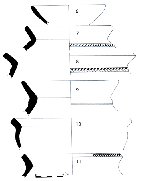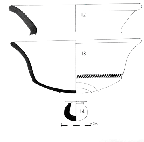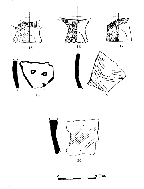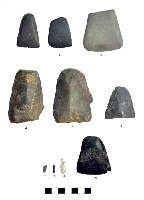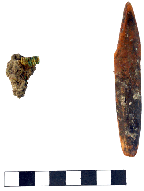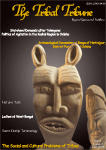Archaeological Excavation at Banga of Harirajpur, District Puri, Coastal Odisha: A preliminary Report
| Dr. Kishor Kumar Basa | |
| R. K. Mohanty | |
| D. Sahoo | |
| S. Vaidya |
| Abstract | Methods of Excavation |
| Introduction | Recoveries |
| Objectives of the Excavation | Cultural Phases |
| Evidence of Human skeleton |
The present paper is a preliminary report based on the excavation at Banga (85043’0” E. Long. and 20008’45” N. Lat.), Harirajpur District Puri conducted by the Centre of Heritage Studies, Bhubaneswar, Department of Anthropology, Utkal University and Deccan College, Pune. In order to appreciate its importance one has to take note of the excavations of the early historic site of Sisupalgarh and the Neolithic-chalcollithic site of Golabai (Near Tangi). The excavation of the early historic urban centre at Sisupalgrah poses an important problem. Whether there is any evidence of protohistoric cultures of early farming communities around Sisupalgarh preceding urbanization there. The site of Banga, Harirajpur answers that question well. An intensive exploration carried out around Harirajpur area of Puri district in Odisha has resulted in the discovery of a habitation mound at Banga, Harirajpur. The surface exploration has yielded ground and polished lithic implements, various ceramic remains and highly corroded animal remains. Hence it was decided to undertake vertical excavations of five trenches (each trench measuring 1.5m x 2.0 m each) in a stepped manner. This revealed continuous occupation from Neolithic to the Chalcolithic periods.
| Archaeological excavations were conducted during January-February 2013 at the Neolithic-Chalcolithic site of Harirajpur, (at Banga 85043’0” E. Long. and 20008’45” N. Lat.), District Puri, Odisha by the Centre for Heritage Studies, Bhubaneswar in collaboration with Department of Anthropology, Utkal University, Bhubaneswar and Deccan College Post-Graduate and Research Institute, Pune. The excavation was jointly directed by Professor Kishor K. Basa and Professor R. K. Mohanty (Deccan College, Pune). They were assisted by Shri D. Sahoo, Senior Lecturer, Department of Anthropology, Utkal University and Shri Santanu Vaidya of Deccan College. Dr. Anam Behera, Department of Ancient Indian History, Culture and Archaeology had discovered this site. Students of the Department of Anthropology, Utkal University participated in the excavation. It was decided to undertake vertical excavations of five trenches (each trench measuring 1.50 m x 2.00 m each) in a stepped manner. This revealed continuous occupation from Neolithic to the Chalcolithic periods. Apart from cultural artifacts ascribable to Neolithic- Chalcolithic period, a nearly complete human skeleton of an adult individual of the Chalcolithic period was recovered from the site. The skeleton was buried in an extended supine position with East-West orientation. |
Figure-1: Location of the Excavated site at Banga, Harirajpur Toposheet No: F45T-12 Figure-2:Satellite Imagery of excavated mound at Bang-Harirajpur, Odisha (Source:Google Earth) |
Excavations at the site were undertaken with following objectives keeping in mind.
1. Sisupalgarh and Dhauli are well known early historic sites. Sisupalgarh was an urban center. Recently the early levels at Sisupalgarh are dated to about 8th-7th century B.C. So the obvious question is whether there is any evidence around Sisupalgarh prior to its early historic level. To be more specific whether there is any Chalcolithic and Iron Age evidence around or in proximity with Sisupalgarh. Bang near Harirajpur is one such site located about 25 km to the south of Sisupalgarh. If Chalcolithic and Iron Age evidence could be found the culture sequence prior to the urban phase could be traced back to at least Chalcolithic period.
2. From a surface survey, evidence of Chalcolithic period is known from Harirajpur showing similarity in pottery with Golbai Sasan which is about 40 km south from Harirajpur.
3. The excavation at Golbai Sasan (Period I) has shown evidences of Neolithic culture. Hence an attempt was also made to find out whether there was any evidence of Neolithic culture at Harirajpur.
Considering the time and resources, excavation at the mound was accomplished adopting methods of vertical earth probing and hence it was decided to excavate trenches in a stepped manner. Five trenches A, B, C, D, E each measuring 1.50x2.00 m have been excavated leaving 1.50x3.00 m area gap between two trenches and the gap area between two trench are named as A1, B1, C1, and D1. The five trenches were laid out in a linear manner in one alignment at the western escarpment of the habitation mound of Bantala Mundia. Thus the trench- A was laid out on the top level and the other four B, C, D, E are laid out to the west of the trench- A at subsequent levels of the slope on the mound. So that the trench- A was located at the top level on the east and the trench- E was located at the lower most level close to the agricultural land on the west. Simultaneously the trenches A, B, C, D, and E were excavated following the step trenching pattern keeping in mind that the trench- C as the index trench to establish the cultural chronostratigraphy of the site.
 Figure-3:Trench A |
 Figure-4:Trench B |
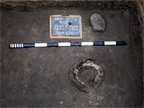 Figure-5:Trench E |
Habitation floors were found including fire place / hearth, ash and charcoal, ground and polished axes and adzes, sherds of base, body and rim of various ceramic wares (red ware, black and red ware, red-slipped ware, red-polished ware etc), cord impressed, reed impressed and perforated potsherds, remains of terracotta figurines of animal and man, remnants of a copper object, a bone point / bone spearhead, fragmented and charred bones of different animals, bovine teeth, charred carapaces of turtle, shells of snails and oysters as well as paddy-husks impression in the burnt clay fragments. Besides, a nearly-complete, well-preserved human skeleton of an adult male individual with a remnant of a copper bead at its neck from the excavation is a landmark in the archaeology of Odisha. On the basis of similarity of material recovery with Golabai, the skeleton could belong to a period between 4000 and 3500 years ago
The mound was excavated up to a depth of 6.50m. The excavations revealed two fold deposits of cultural phases: (a) Period I- Neolithic Phase and (b) Period II- Chalcolithic Phase. These cultural phases and their features are as follows:
Period I- Neolithic Phase:
Evidences of Neolithic period have been retrieved from only one trench i.e trench- C. The material remains of Neolithic Phase (Period I) include a ground and polished axe on basalt, a good number of both handmade and wheel made ceramic remains, a few microliths like a borer and a fragment of backed blade on brown chert, remains of animasl and plant remains. The ceramic assemblage includes rim, body and base sherds of dull red ware, red ware (with grey core, red ware with black core), red ware with red slip, red polished/slipped ware, red slip/wash ware, black and red ware, perforated red ware and cord or reed impressed red ware. The shapes are deep or shallow bowls with featureless convex or straight rims, storage jars, high necked and constricted necked vessels (handi) - big and small pots, bowls, dishes, lids and pot stand or pedestals. A few pieces of body sherds of cord impressed ware comparable to the Neolithic pottery types reported from some other sites of eastern and north eastern India have been found in this period. Only two pieces of body sherds of the perforated red ware belonging to this period have also been retrieved from the trench C.
Period II- Chalcolithic Phase:
The material remains of Chalcolithic Phase (Period II) include a few microliths like a piece of carnelian flake / blade, a blade on grey chert and a good number of ground and polished artefacts like an axe on basalt, two adzes - one on basalt and the other on dolerite-, three pieces of broken Celts on dolerite, various ceramic and terracotta remains including animal and anthropomorphic figurine, animal and plant remains. This deposit also produced a skeleton of an adult male individual with a remnant of a spiral copper bead at its neck part.
The ceramic assemblage includes a good number of rim, body and base sherds of dull red ware, red ware (with grey core, red ware with black core), red ware with red slip, red slipped / washed ware, black and red ware, black polished ware, chocolate slipped ware perforated red ware and cord or reed impressed red ware, grey ware and body sherds of carinated red ware. The identifiable shapes include deep or shallow bowls, storage jars, high necked and constricted necked vessels (handi), narrow necked pitcher (kalasa), bowls, dishes, and bowl on stand, lids and pot stand or pedestals. The body sherds of cord impressed ware also continued during this period. Body sherds of the perforated red ware have also been retrieved from this phase.
Figure-6: Neolithic and Chalcolithic Potteries from Harirajpur, Odisha
|
Figure-7: Lithic Artefacts from Harirajpur, Odisha. 1, 2, 3, 4, 5 and 6 - Ground and Polished tools of Chalcolithic Phase. |
Figure-8: Copper and Bone objects from Harirajpur, Odisha A piece of Copper Bead Embedded in a clay nodule and 2- A Bone Spearhead of Chalcolithic Phase. |
A nearly complete human skeleton of a male has been discovered associated with a vessel (handi) on red polished ware with grey core and a deep dish on red washed ware with grey core as grave gifts at a depth of 5.63m below the top level in the trench E (extended as EX for easy lifting of the skeleton). From this level a beautiful spear head on bone, manufactured by ground and polished technique has also been found close to the head of skeleton at western direction. The association of Chalcolithic pottery types and a spiral wire bead of copper at the neck part of the skeleton imply that the dead belongs to the Chalcolithic phase.
A team of experts, comprising Prof. S. R. Walimbe and Dr. Veena Mushrif-Tripathy, from Deccan College visited the Anthropology Department of Utkal University to conduct anthropological investigations on the skeleton. A Workshop on Skeletal Remains from Harirajpur was organized by the Department of Anthropology under the Centre of Advanced Study Programme (U.G.C.) from 12.3.2013 to 18.3.2013 in which Prof. Walimbe and Dr. Mushrif-Tripathy acted as Resource Persons. Faculty members and students participated in the said Workshop. The following are important inferences on the skeleton studied by Prof. Walimbe and Dr. Mushrif-Tripathy.
The adult represented is a male, died at the age of around 35-40 years, is tall (stature estimation is 169.44 cm, or 5’7”) with slender body built, and resembling local Odishan population in the facial morphological features. The individual was apparently healthy. Bones did not show any sign of infection. There is, however, a significant evidence of healed fracture of left forearm. The left side ulna and radius exhibit oblique fracture resulting from an indirect trauma. This incidence took place during the adult phase of the individual (around 25 years of age), and the fractured bones were completely healed. The injury cannot be taken as indicative of inter-personal clash, but was probably caused by an incidence like falling from tree. The secondary infection, if any, to the open wound was successfully treated. The individual had perfectly normal life once the fracture was completely healed, though had some deformity caused by shortening of the forearm. In any case the injury cannot be taken as cause of death. On the other hand, successful treatment to such kind of serious injury is an indicative of availability of skilled medicinal assistance in the vicinity. It also strongly suggests a very stable social system willing to take care of the disabled that existed in rural Odisha about 3500 - 4000 years ago. There are signs of certain other minor illness, like ante mortem loss of one upper molar tooth, traces of age related arthritic problems. The cause of death cannot be positively asserted. For that matter, death is not ‘untimely’. The average death age during the Chalcolithic period is stated to be around 40 years. The portion below ankle was probably chopped off. No foot bones are seen in the collection and there are likely signs of cut-marks on the distal end of tibia. It may be noted that practice of cutting lower feet of the dead prior to burial was a common practice in the Deccan Chalcolithic populations.
For scientific analysis skeletal sample of the human skeleton has already been sent for possible DNA extraction to Centre for Cellular and Molecular Biology, Hyderabad. Confirmative statement on biological affinity of the individual can be forwarded only after these results are available. Absolute chronological dating will eventually be done by Radiocarbon dating method. Plant and animal remains from the excavated site have been sent to the Deccan College for further detailed study.
Needless to say the site of Harirajpur has generated a lot of interest among archaeologists, local people and heritage lovers of the State. One could say that when studied in details, the excavations at Bang-Harirajpur would provide an example in respect of the emergence of early farming community in Coastal Odisha. Hence, it is necessary that the site at Bang, Harirajpur should be excavated in a bigger scale since the site has great importance in terms of the heritage of the State of Odisha.
Figure- 9: Human Skeleton in the Trench – E from Harirajpur, Odisha




